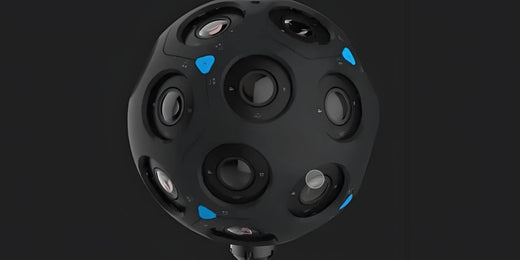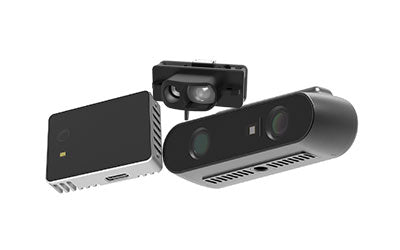What does a ToF camera do? Key Advantages and Application Areas

Characteristics of TOF Cameras
TOF (Time-of-Flight) cameras utilize flight time technology to obtain depth information of objects. The basic principle involves emitting light signals and measuring the time it takes for the light to return to the camera to determine the distance of objects. Compared to traditional machine vision systems, TOF cameras have significant technical advantages. They consist mainly of a light source, optical lens, TOF chip, and processing circuitry. Unlike traditional 3D laser sensors that scan point by point, TOF cameras can simultaneously capture depth information for the entire image.
Advantages of TOF Cameras
-
Accurate Depth Information Acquisition
TOF cameras measure the distance between the object and the camera using the flight time of light signals, enabling precise acquisition of scene depth information. Compared to traditional 2D images, TOF cameras provide more detailed spatial data, helping to distinguish between the foreground and background of objects clearly. This precision is crucial for applications requiring accurate 3D space analysis, such as virtual reality and augmented reality. -
Fast Real-Time Processing
TOF cameras can quickly capture and process depth data, providing real-time feedback on changes in the scene. This rapid processing capability makes TOF cameras excel in applications like autonomous driving and robotic navigation, where immediate reaction is necessary to recognize and handle complex situations in dynamic environments. -
Efficient 3D Modeling
TOF cameras can create detailed 3D models, supporting various 3D modeling applications. By combining depth information with image data, TOF cameras generate high-precision 3D models for use in 3D printing, virtual reality, and augmented reality, offering a highly realistic 3D visual experience. -
High Data Acquisition Rate
TOF cameras can quickly collect large amounts of data without moving parts due to their use of high-frequency modulated light sources and high-precision sensors. This high data acquisition rate is effective for scenarios requiring large-scale data analysis and complex environment recognition. -
Broad Application Scenarios
TOF cameras are used in various fields, including autonomous driving, industrial automation, facial recognition, logistics, security, and robotics. Their efficient depth perception capabilities provide accurate data support, enhancing the intelligence and operational efficiency of systems in these fields. -
No Need for Scanning Devices
Unlike traditional scanning equipment, TOF cameras do not rely on moving scanning devices to perform depth measurements. This feature makes them perform well in dynamic environments, suitable for scenarios requiring rapid measurement and dynamic detection, such as real-time tracking and motion analysis. -
High Cost-Effectiveness
Although the initial investment in TOF cameras is relatively high, their core components, such as CCDs and LEDs, are relatively low-cost, promoting widespread production and application of TOF technology. With technological advancements and increased production scale, the cost-effectiveness of TOF cameras is expected to improve, making them more widely adopted across industries. -
Flexible Data Processing Capability
The data processing system of TOF cameras can perform real-time depth data correction and analysis. This flexible data processing capability allows TOF cameras to meet various complex application requirements, such as precise depth measurement, target recognition and tracking, and 3D reconstruction of dynamic scenes. -
Enhanced User Experience
In consumer electronics, such as gaming and home entertainment, TOF cameras provide a natural and intuitive user interaction interface. Through precise gesture recognition and facial capture, TOF cameras enhance the user experience, providing a more immersive interaction. -
Adaptability to Various Environmental Conditions
TOF cameras use active light detection, allowing them to work stably under different lighting conditions. Compared to traditional passive light measurement systems, TOF cameras maintain high precision in low-light and strong light conditions, enhancing their applicability in various environments.
Application Fields of TOF Cameras
-
Automotive Industry
In autonomous driving, TOF cameras improve driving safety through precise depth perception. They are also used in in-car passenger detection systems to ensure passenger safety and comfort. -
Industrial Field
In highly automated factory environments, TOF cameras act as human-machine interfaces (HMI), monitoring and controlling the safety distance between workers and robots in real time, thereby enhancing production efficiency and safety. -
Facial Recognition
TOF cameras, combined with brightness images and depth information, can quickly and accurately perform facial matching and recognition, widely used in security verification and personalized services. -
Logistics Industry
TOF cameras can quickly measure the volume of packages, optimizing packaging and freight cost assessments. This application helps improve logistics efficiency and reduce costs. -
Security and Surveillance
TOF cameras can perform crowd counting and flow analysis, used in security systems for area monitoring and traffic management in complex systems. -
Machine Vision
In industrial positioning, guidance, and volume estimation, TOF cameras replace traditional infrared safety control devices, enhancing production safety and efficiency. -
Robotics
TOF cameras provide depth vision for robots, enabling environmental navigation, path planning, and obstacle avoidance, enhancing robots' autonomy in complex environments. -
Medical and Biological
TOF cameras play a crucial role in foot orthotic modeling, patient activity monitoring, and surgical assistance, providing precise 3D data support for the medical field. -
Interactive Entertainment
In motion gesture detection and facial recognition, TOF cameras provide precise depth information for entertainment advertising and special effects production in films. This makes TOF technology an essential input device in virtual reality and gaming, enhancing user experience.
TOF cameras provide accurate 3D depth maps by measuring the distance between objects and the camera. They can capture 3D images at high speeds, making them ideal for applications like mobile robots that need precise depth range data for navigation. With high dynamic range (HDR), TOF cameras work well in varying lighting conditions, ensuring reliable performance in both bright and low-light environments. This makes them essential for real-time obstacle detection and efficient operation in complex environments.
Conclusion
TOF cameras demonstrate significant potential in multiple fields due to their real-time depth perception and efficient data processing features. Despite some limitations, such as high costs and susceptibility to environmental influences, the advantages of TOF technology make it vital in applications such as autonomous driving, industrial automation, facial recognition, logistics, security, robotics, medical, and interactive entertainment. As technology advances and costs decrease, the application range of TOF cameras is expected to expand, making them indispensable components in future intelligent systems.
Applicable products:CS20, CS30 , CS20-P, CS40,CS40p
Our professional technical team specializing in 3D camera ranging is ready to assist you at any time. Whether you encounter any issues with your TOF camera after purchase or need clarification on TOF technology, feel free to contact us anytime. We are committed to providing high-quality technical after-sales service and user experience, ensuring your peace of mind in both shopping and using our products.
-
Publié dans
Tof sensor






